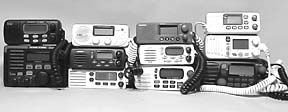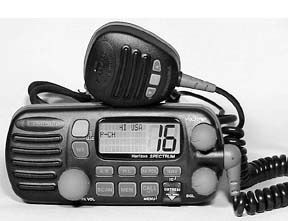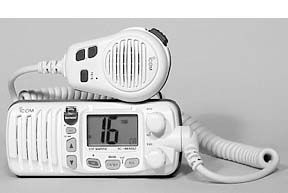
The VHF radio has been and probably will remain a boater’s primary means of communication in an emergency. While cellular phones can be extremely valuable when you’re in trouble, they don’t provide a simple, reliable, direct and instantaneous link with the Coast Guard and other boaters within line-of-sight of your antenna.
VHF radio technology has recently improved with the advent of DSC (Digital Selective Calling), which allows you to send digitally encoded information-including your boats ID number and coordinates-to other DSC-equipped vessels. This distress signal automatically activates an alarm on other DSC radios within range. In addition, both sending and receiving radios automatically turn to Channel 16 so communication can begin.
The problem is that the Coast Guard wont have DSC capability-at its 44 group command stations or on its rescue boats-until 2006, according to Lt. Bob Schambier, the CG’s search and rescue program analyst. DSC technology is part of a larger $300 million communications upgrade expected to be completed in 5 years, says Schambier.
The Coasties won’t hear your digital Mayday, but other recreational boaters with DSC might, and many commercial vessels are now DSC-equipped. That said, we think DSC-equipped radios are worth the few extra dollars you’ll be asked to pay.
DSC is required on all newly designed radios but not on all VHFs which are sold. Currently the market penetration for DSC-equipped radios is very small. New models accepted by the FCC after June of 1999 must have DSC. Old models can continue to be made by manufacturers.
What We Tested
We most recently tested fixed-mount VHF radios in 1997-low-end radios in our February 1 issue, and high-end units in our July 15 issue.
For this test, we rounded up 11 fixed-mount marine VHF radios from six manufacturers. Five of the models were equipped with DSC. Our test models ranged from $100 to $350.
How We Tested
We first thoroughly tested each radio on a workbench using a top-of-the-line IFR COM-120B communications service monitor. This very sophisticated and expensive piece of test equipment verifies all of the radio’s specifications. We performed tests for receive sensitivity, transmit modulation levels, spurious and harmonic emissions, frequency accuracy, and frequency stability.

In addition, we varied the input voltage to each radio to simulate operation from a weak battery. The radios were also taken from an air-conditioned shop and left out in the sun for several hours to check for any adverse changes triggered by the higher temperature.
With the exception of transmitter power output at both 13.8 VDC and 11 VDC, we translated our technical findings into a much more understandable numeric rating. To these numbers we also added subjective ratings for the clarity of both transmit and receive audio as well as an ergonomics rating based on each radio’s ease of use. Our results are shown in the chart on page 16. A discussion of each model follows.
Uniden MC-1020 & President LTD-915
The Uniden MC-1020 and President LTD-915 (actually made by Uniden) are physically identical radios that differ only in the availability of several extra features. Both radios include all of the basic VHF features such as scanning and memory channels. The MC-1020 extends this feature to include a PA speaker (hailer) output, weather alert function, and a dimmable display backlight. Simply put, the LTD-915 is a limited version of the MC-1020.
Both of these models tested marginally. Receive sensitivity was good but intermodulation interference rejection was poor. Their displays were adequate but not great. Receive audio quality was substandard and, in our opinion, not loud enough. Frequency measurements while transmitting for an extended period showed a steady drift downward in frequency. Their transmitter audio was good.
Bottom Line: The Uniden MC-1020 and President LTD-915 both performed marginally in our tests. In our view, they are substandard compared to the other radios.
Icom IC-M502
The IC-M502 is Icom’s top of the line marine VHF radio. In both construction and performance, Icoms efforts to design a superb radio are easily appreciated. The IC-M502 looks different than most other VHFs. Its front profile is much larger but it is considerably flatter than other models. This simplifies flush-mount installation by requiring less room behind the radio. More importantly, this approach allows for much larger, easier-to-use controls, a big and very readable display, and a larger-than-average speaker. We especially liked Icom’s three-knob control approach with separate volume, squelch, and enlarged channel-selector knob. This last control makes changing channels much easier and faster than pushbuttons.
Icom has included full DSC functionality with the M502. We especially liked the hinged cover over its distress key. It ‘s obvious and easy to operate in an emergency, and won’t detach and get lost during normal use.
During testing, the IC-M502 performed flawlessly. It had the best receive sensitivity, best receive audio sound and even best transmit audio. Its receiver was also the most immune to adjacent channel interference and intermodulation distortion. For whatever reason, Icom did not include an extra-long microphone cable with this radio. This has us a little puzzled considering that its less expensive models have these.
Bottom Line: The Icom IC-M502 is clearly a top-rate, commercial-quality marine VHF radio. It excelled in all of our tests. We were also surprised to find it priced below $300. The IC-M502 is definitely our top pick.
Icom-M402
Icoms M402 is a conventionally shaped VHF model with DSC capability. Despite its small size, it includes an enlarged display. Volume and squelch are adjusted by conventional knobs while channel selection and all other functions are controlled by pushbuttons. A small but readily visible distress key-protected by an attached flip cover-is to the left of the display.

The M402 performed very well. Receive audio quality was excellent, especially for such a small radio. We liked Icom’s channel tagging (also included on the M502), which lists the FCC assigned use of each channel as it is displayed. For example, channel 22a shows “USCG” on the display. Transmit and receive performance were excellent. Receive audio quality was especially notable.
Bottom Line: The Icom-M402 is a well-built, top-performing radio at a fair price. We recommend it highly.
Icom-M45
This basic, entry-level VHF radio is constructed in the same style as Icom’s M402, with the exception of a smaller display and no DSC. Volume and squelch knobs are located on this models right side. Six pushbuttons positioned under its display take care of all other functions.
The M45 is advertised as “Simple, Rugged and Reliable.” We couldnt agree more. Like its more upscale brothers, the M45 tested exceptionally well. Receive audio was excellent. It is very well made and designed for easy use. All other test results were superior, too.
Bottom Line: The Icom M45 is simply a good quality, well-designed radio. It is an excellent choice for any boater who does not see the need for DSC capability. We rank it as our best buy in non-DSC VHF radios.
Uniden MC535
Often available for just under $100, the Uniden MC535 is the least expensive VHF tested. It is the only model tested that uses an LED channel display-which is outdated technology. We don’t see many of these displays on any electronic equipment anymore.
Volume and squelch are controlled by knobs, while buttons along the side and bottom of its display control other functions. The M535 is lightweight, in fact, much lighter than we would anticipate, given its size.
The M535’s receive and transmit audio quality are noticeably inferior compared to the other radios tested. Its lack of good interference rejection was evident and its receiver was frequently overloaded by nearby off-channel transmitters. It is poorly designed from an ergonomic standpoint, in our opinion. For example, weather channels can only be accessed by stepping through all of the other marine channels.
Bottom Line: The Uniden MC535 is the least expensive VHF radio tested. Its performance was also the worst. Not recommended.
Ray-53
The Raymarine (formerly Raytheon) Ray-53 is the lowest-cost DSC radio tested. It is a small, conventionally styled model with nested volume and squelch knobs and a larger channel knob. Four pushbuttons under its display allow for control of other functions. Its DSC distress key is under a flip-open cover on the back of its microphone.
We found its display sufficiently large but were unhappy with its non-uniform red backlighting, which limits the functionality of this model’s DSC capabilities. It is simply incapable of adequately displaying DSC information, such as position data or DSC call types.
The Ray-53 did perform well during testing. Its receive sensitivity was very good, and frequency stability and interference rejections were slightly above average. However, receive audio quality could be much better, in our view. The Ray-53’s distress key is basically hidden from view and hard to access, far from an ideal arrangement in an emergency. Furthermore, its location occupies the space normally reserved for a microphone hanger, therefore precluding a hanger for the microphone.
Bottom Line: The Ray-53 is far from Raymarines best effort. There are better choices for a DSC-capable marine radio in this price range.
Alinco DR-MA1
Alinco Inc., a Japanese manufacturer of amateur radio equipment, is generally known for providing a good value in lower-cost equipment. This model is its only current entry in the marine VHF arena. Unlike the others tested, the Alinco does not seem to be available through normal marine distribution channels such as West Marine or BoatU.S.
The DR-MA1 is a small, stylish radio with simple display, volume and squelch knobs and eight pushbuttons for function control. Its speaker is of a good size for a radio this small and produced crisp and loud receive audio. All standard VHF radio functions are supported, but extras, such as a weather alert, are not available.
Receive sensitivity, transmit frequency stability and other parameters were all average. Transmit audio was very good, however.
Bottom Line: The Alinco DR-MA1’s performance makes it usable but not exceptional. We recommend it as a low-cost option.
Shakespeare SE2510
This full-featured non-DSC VHF marine radio is of typical size and shape. Volume and squelch knobs are located on its right side. Immediately to the left are channel up and down keys. Four additional keys below its display control other functions. The SE2510s display is large and very readable.
This model was an average performer during our tests. Receive audio was loud but a little tinny. Our major complaint is that its microphone cord seems thin and rather flimsy. Transmit audio was good. Receive sensitivity was also acceptable.
Bottom Line: The Shakespeare SE2510 is a good, simple marine VHF. We found no major flaws, but little about this model excites us.
Standard Horizon Intrepid & Intrepid LE
The Intrepid and Intrepid LE are nearly identical. Their only difference is that the less expensive LE version does not include a connector for Standard’s optional “RAM” remote microphone. The Intrepid radios are designed with a small chassis and enlarged front panel, which greatly increases the space available for controls and display, and makes flush-mounting very easy.
The Intrepid has a large and sophisticated display that includes space for short operational menus and DSC data. The oversized volume and squelch knobs’ non-slip rubber enhances ease of operation. The distress key cover, located below its display, is not hinged, so it will very likely become detached and lost.
The Intrepid performed very well. Receive and transmit audio quality were excellent. Intermodulation rejection was superb. Receive sensitivity was more than acceptable.
Bottom Line: The Standard Intrepid radios are an excellent buy. They are well made, sophisticated, perform very well, and are fairly priced. We appreciate the availability of the LE version for less money without remote microphone capability.
Standard Horizon Spectrum GX2350
The Horizon Spectrum is Standard’s top-end entry into the VHF market. This radio has every expected VHF and DSC feature and lots of bells and whistles. This is made possible by Standard’s integration of a 20-watt loudhailer into the radio. The hailer function literally allows you to select your choice of bell or whistle sounds, including preprogrammed foghorn patterns. Like Standard’s Intrepid, the Spectrum has an enlarged front panel. A slightly larger combination channel selector/PA volume knob supplements its volume and squelch knobs. Its distress button is located below the display and, like the Intrepid, is shielded by a snap-on cover. This model’s most notable feature is its extra-large display. Channel and DSC information was clearly legible.
The Horizon Spectrum performed excellently. Its only apparent flaw was that its transmit audio level was slightly lower than we would have liked.
Bottom Line: This radio is the most expensive model tested, but it also performed exceptionally well. If you want a good radio with a lot of features, we recommend it. However, we think that the Icom IC-502 is a better radio at a lower cost.
Conclusion
Icom continues to be the leader in the VHF marine radio field. The company’s radios are innovative and of consistent high quality.
Standard’s entries were also impressive. Standard has quickly mastered the most functional DSC arrangement. Shakespeare and Alinco continue to produce adequate but unremarkable radio models. Uniden, given its experience in the commercial two-way radio market, was disappointing with its current selections, in our opinion. Jim Cassidy, Uniden senior VP of product planning, defended his radios, saying they offer excellent value for the dollar. He also said Uniden knows they make a good product because they sell a lot of VHF radios and have a low return rate. (He declined to give specific figures.)
The Raymarine Ray-53 was also disappointing, particularly because we’ve come to expect consistently good output from this well-established company. We expressed our concerns to Raymarine representatives via phone and e-mail, but as of press time they hadn’t responded.
VHF radios have advanced over the past several years. Radio specifications have improved considerably and more emphasis is being placed on ease of operation. We expect that non-DSC models will be phased out and that DSC radios will be less costly.
Contacts – Alinco, Atoc Amateur Distribution, 23 South High St., Covington, OH 45318; 937/473-2840; www.alinco.com. Icom America, Inc., 2380-116th Ave NE Bellevue, WA 98004; 425/454-8155; www.icomamerica.com. Raymarine Inc., 22 Cotton Road, Unit H, Nashua, NH 03063; 603/ 881-5200; www.raymarine.com. Shakespeare Composites & Electronics Division, 19845 Highway 76, PO Box 733, Newberry, SC 29108; 803/276-5504; www.shakespeare-ce.com. Uniden America Corp., 4700 Amon Carter Blvd., Ft. Worth, TX 76155; 800/586-0409; www.uniden.com.Vertex Standard, 17210 Edwards Rd., Cerritos, CA 90703 U.S.A; 562/404-2700; www.yaesu.com.
Also With This Article
Click here to view the Fixed-Mount VHF Radio Value Guide.



































Why don’t most of the VHF radios have detached bluetooth mic’s/remotes? I have a small sail boat with very limited space and like to have an uncluttered helm. I was trying to avoid running more wires up the binnacle to mount a wired remote mic/remote. Any suggestions?